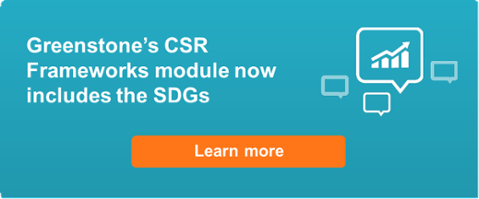Everything you need to know about the new GRI Standards
 Last month saw the launch of the latest version of the sustainability guidelines produced by the Global Reporting Initiative (GRI). The new ‘GRI Standards’ take reporting organisations away from the static nature of the GRI G4 framework and into what GRI are dubbing a “more flexible and future-proof” set of reporting guidelines. Here is everything you need to know.
Last month saw the launch of the latest version of the sustainability guidelines produced by the Global Reporting Initiative (GRI). The new ‘GRI Standards’ take reporting organisations away from the static nature of the GRI G4 framework and into what GRI are dubbing a “more flexible and future-proof” set of reporting guidelines. Here is everything you need to know.
Background
The new Standards were announced by the GRI in October and are being officially launched in a series of global events. Developed by the Global Sustainability Standards Board (GSSB), the GRI Standards aim to build on the previous GRI G4 framework to help companies around the globe be more transparent in all areas of sustainability and to help organisations contribute to the UN Sustainable Development Goals (SDGs).
Included in the GRI Standards are 3 universal standards and 33 topic specific standards covering economic, environmental and social reporting metrics.
What has changed?
Firstly, it is important to note that this is not ‘GRI G5’ and that the bulk of the G4 content remains and is still valid. As such, if your organisation is already reporting in accordance with GRI G4, the new reporting process should not be significantly different. However, there are a number of changes that all reporting organisations should be aware of:
Standard vs. standards – as mentioned previously, the framework now comes in the form of 36 modular standards in comparison to the singular structure of GRI G4. This complete restructuring allows GRI to update individual topic areas without having to republish the entire framework, increasing flexibility and agility whilst ensuring that the guidelines can stay up to date and reflective of the ever-changing sustainability landscape.
Content revisions / clarifications – although the majority of the G4 content is still valid, there are some content changes. These are grouped into two categories: content clarifications and content revisions. Content clarifications are minor changes where the reporting criteria is unaffected whereas content revisions are larger scale changes with actual implications on the requirements. Although there are few of them, these revision changes are clearly detailed in documents provided by the GRI, so it is recommended that organisations review them in the context of their own reporting.
Language change – some of the key terminologies used in GRI G4 have also been changed. The G4 indicators are now disclosures, aspects are topics and disclosure on management approach (DMA) is now referred to as management approach to disclosure.
Transitioning from G4
As mentioned previously, an important first step is to assess the minor changes to the guidelines in the context of your organisation’s reporting purposes. This can be achieved by reviewing the GRI’s Mapping G4 to the GRI Standards document, which provides an extensive matrix of how every G4 indicator links to the GRI Standards, including any content clarifications/revisions.
With the GRI Standards replacing the current G4 guidelines entirely, organisations will need to use the updated framework for all reports published on or after 1st July 2017.
Greenstone and the GRI Standards
Greenstone’s CSR Frameworks module has been designed to meet the requirements of GRI’s sustainability reporting framework and enable companies to easily produce a GRI report. Our software was one of the first software tools to achieve G4-certification under GRI’s Certified Software and Tools Program. From early 2017, our software and certification will include the new GRI Standards.
Using Greenstone’s software, companies can:
- Define bespoke question sets from a range of reporting frameworks, including GRI, CDP, SDGs, UNGC and many leading financial exchange reporting schemes, based on the relevance and materiality to their organisation.
- Create custom questions to cover any additional company-specific KPIs and metrics which can be integrated into questionnaires alongside content from reporting frameworks.
- Collect data and supporting information across a diverse organisation.
- Consolidate data into internal and external reporting templates.
- Analyse quantitative data on dashboards to assess performance and track progress over time.
The current module functionality includes detailed mapping of GRI to other recognised frameworks including ISO 26000, OECD Guidelines for Multinational Enterprises, SDGs and the UN Global Compact. This mapping allows users to report to multiple frameworks in the same streamlined process, minimising the reporting burden. Once the new GRI Standards are available in the module, we will go through the same process to apply this framework mapping to the updated guidelines.
For more information on the new standards, please visit this link










